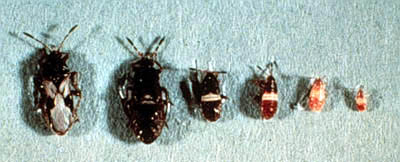Chinch bugs

Identification
Adults are about 1/5 inch long and light in color with small black triangular patches on the wings. The wings are carried folded over the back. The nymphs are from 1/20 to 1/5 inch long and vary in color from reddish with a white band across the back to black as they near adult size. Chinch bugs occur throughout the state.
Life Cycle and Biology
The eggs are laid in leaf sheaths or crevices in nodes and other protected places. The young develop into adults in four to six weeks. There are three to four generations a year. The bugs insect their slender beak into the grass ans suck the plant juices.
Damage
Typical injury appears as spreading patches of brown, dead grass. St. Augustine grass is the most seriously injured, but other lawn grasses, including zoysia, bermuda, bahia, and centipede grasses, also are subject to attack. Chinch bug infestations and damage are most often first noticed during hot dry periods in sunny areas of the lawn.
Control Strategies
A common method of determining population levels of chinch bugs is the "flotation technique". A coffee can, or similarly sized can, with its ends cut away, is pushed two to three inches down into turf in a suspected area of chinch bug infestation. The can is filled with water and kept full for about five to seven minutes by adding more water as necessary. All stages of chinch bugs, if present, will float to the top. A threshold level of 20 to 25 chinch bugs per square foot can cause damage. This monitoring technique should be repeated in several spots at the edge of the suspected area to increase chances of finding the bugs. Treat if populations are at or above the damage threshold. Pesticides should not be applied to turf in dry soil to avoid potential chemical injury. Irrigate the lawn several hours to a day before treating.
